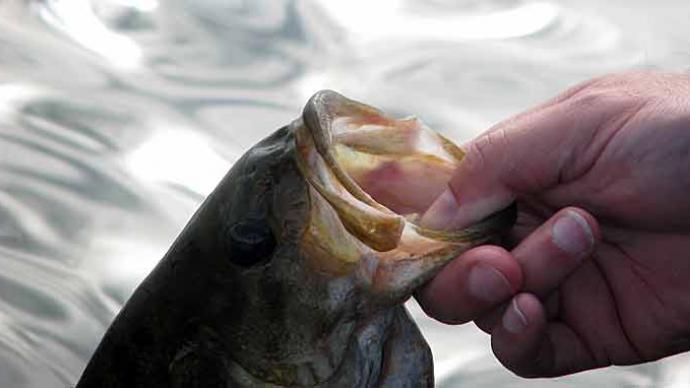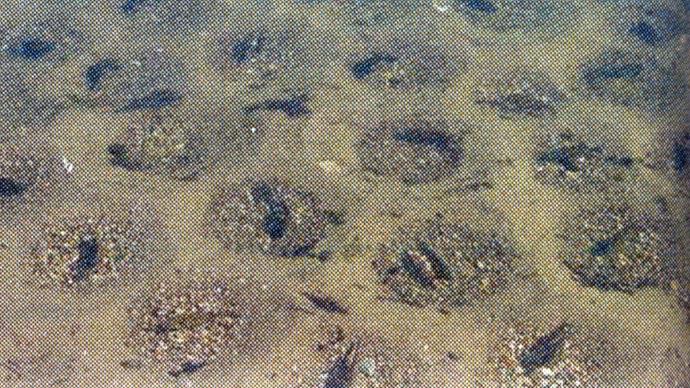
An interesting question was recently spawned by a thoughtful pondmeister. "Does experience tell you which quarter of the year a largemouth bass will be its heaviest?" The question was posed because this conscientious landowner has been studying his tagged bass in a pretty intense mark/recapture project in his small waters. Weighing and measuring bass for a couple of years triggered his thinking. Couple that logic with the fact he's been raising feed-trained bass for a few years and he's seeing some natural trends—or is he?
Largemouth bass are heaviest at the beginning of spawn, usually late March or early April depending where you are, especially in the south. In the Midwest, the spawn may be a little later, maybe April or May and in northern waters even a little later. The big girls are fully egg-laden, as they've been feeding heavily for three or four weeks and are at prime weight for the entire year. As the eggs mature and prepare to be expelled, fertilized and clumped into a nest, the eggs are as large as they'll get and ovaries take up the majority of her body cavity. The males, just before spawn, are in the best condition they'll be all year. During spawn, the girls lose a significant amount of weight as they lay their eggs and the males lose weight because they don't feed when they tend the nest.
After bass spawn, water is warming and the food chain is beginning to build again as the baitfish spawn and build their numbers. Baitfish are mostly eaten over the winter months and since they don't spawn at that time, their numbers are depleted by the time bass spawn. Baitfish have to rebuild their numbers, too.
One of the fascinating facts about Mother Nature under water is the order in which things happen and the spawn is one of the most interesting examples. Fish spawn according to temperature, all other things being equal. Equal means good habitat and spawning substrate. In warm water systems, crappie spawn first, (where they exist) then bass, then bluegill, then redear sunfish. Channel and blue catfish spawn at the end of spring, early summer. As all these fish reproduce, they take advantage of specific temperature windows that may vary as much as five or six degrees and no more.
That's a big reason we rarely see hybridizing in nature. You'd think the different sunfish species would tend to hybridize, especially since they often use the same beds, but unless there's a rapid temperature change and an anxious male of a different species, hybridizing is rare. Fathead minnows start fairly early (if they exist in a system) and so do golden shiners. But, those species require totally different spawning habitat, so there's no overlap of their spawns. Fathead minnows stick their eggs on the underneath side of firm objects and shiners lay their eggs in grass along the shore. About midway through the sunfish spawn, shad start. Threadfin shad spawn before daylight by running along the shore, depositing eggs on grassy substrate. Threadfins spawn in spring, develop more eggs and spawn through the summer several times. Gizzard shad spawn totally different. They may expel 250,000 eggs into the water and leave them suspended in the water. Smaller than the head of a pin, those eggs may or may not hatch and survival rates are dependent on what they have to eat and what might eat them. Add the fact that bluegill spawn several times per year in warm water areas of the nation and they are considered the backbone of the food chain for private waters. Not quite so in northern ponds, which is a story for another article.
Overall, nature has a way of replenishing baitfish during spring so the predator fish have an opportunity to have food growing as the temperatures rise toward summer. After the first rolling spawn settles down toward end of May, other fish are ready to go at it again, especially bluegill and threadfin shad. Over the summer, spawns slow, but the new baitfish are gaining weight (in a perfect world) and as they grow they feed a totally different size-class of predator fish. That's why we pay attention to habitat, especially native species of aquatic plants as a nursery, places for small fish to hide and feed so they can grow into a significant food source for larger fish.
Tie all these factors together in your pond management program and you'll have a much better understanding why timing is so important with your strategies.
Take the spring spawn to the next level in your thought process.
As fish are spawning, eggs begin to hatch. While that might sound novel and a little abstract in a sense, here are a few facts to help you visualize what's going on. Eggs are laid, and based on species, some level of parental care follows. In shad, there is no parental care, but in sunfish, there is. With largemouth bass, a crater has been built, a female with ripe eggs lays them, and the male fertilizes those eggs, clumps them into the bottom of the crater-shaped nest and then stands guard, circling the nest, keeping unwanted marauders at bay until after the eggs hatch. Fertile eggs are yellow and when they hatch, the babies are called sac-fry. That moniker comes from the yellow distended-looking yolk-stomach perched under two dark eyes and a see-through body. Over a few hours or days, the yolk-sac is absorbed and the school of fry begins to rise from the nest. At that point, the yolk is gone and those baby fish need to eat. Imagine, little fish, less than a quarter-inch long, swimming in unison with siblings. They have no stores of body fat and must eat incessantly for a few days or they'll starve. In the meantime, it's a fish eat fish world.
Each species of fish does things a little bit differently. But, they all have a few things in common. Babies need to eat soon after hatching. Imagine the mouth sizes of tiny fish. What's there to eat, especially in crystal clear water? Most of them glean their meals from the water column. That's why biologists tend to recommend fertilizing a pond, especially south of the Mason-Dixon Line. Timing is important. If you miss the timing of fertilizing and don't establish a bloom, survival rates of your babies plummet. Another thing baby fish have in common is that they are wide-open targets of predators. What might eat tiny, newly hatched fish, you might ask? One of their biggest predators, early on, is aquatic insects. Dragonfly nymphs, damselfly nymphs, backswimmers, oarsmen...these bugs absolutely love to eat fry.
Then, what? As the school of fry begins to figure out the ways of the pond, many of them are eaten, and those that survive quickly condition to utilize habitat to escape. That's why you might see one-inch bluegills huddled in shoreline grasses. They'll dart in, dart out and feed and then hide as much as they can. Bass fry grow at different rates and actually the largest ones cannibalize their siblings. I've seen many, many times a tiny, three inch bass with a two inch brother's tail dangling from its maw.
As a pondmeister and manager, part of your job is to realize what's going on and be sure that your pond has everything it needs to facilitate the spawns and survival and feeding of your young fish—when they need it.
Timing, timing, timing.
Understanding how the spawn rolls and how that plays successfully into the concept of habitat and food chain gives you a deeper understanding of the fundamentals of fisheries management.
Now is the time to make sure you've got the best spawning substrate for your target species as you set the stage to offer food to the youngest fish and make sure they have the habitat needed as young fry take the steps into their best roles in your pond.
Reprinted with permission from Pond Boss Magazine


